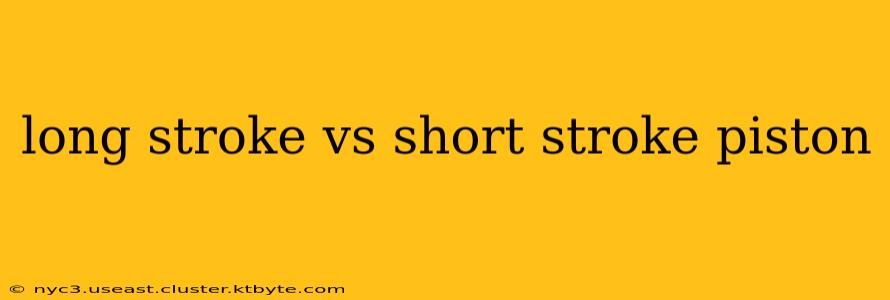Choosing the right piston for your engine is crucial for performance and longevity. A key factor in this decision is the stroke length, which significantly impacts engine characteristics. This article delves into the key differences between long stroke and short stroke pistons, exploring their advantages, disadvantages, and ideal applications.
What is Stroke Length?
Before diving into the comparison, let's define stroke length. It's the distance the piston travels from top dead center (TDC) to bottom dead center (BDC) within the cylinder. This distance, combined with the bore (cylinder diameter), determines the engine's displacement.
Long Stroke Pistons: Power and Torque
Long stroke pistons, where the stroke is significantly longer than the bore, are designed to produce high torque at lower RPMs. This makes them ideal for applications that prioritize pulling power, such as:
- Trucks and SUVs: Their robust torque output is perfect for hauling heavy loads or navigating challenging terrain.
- Marine Engines: Similar to trucks, marine engines benefit from the strong pulling power of long stroke pistons, especially in applications requiring low-speed, high-torque performance.
- Tractors and Construction Equipment: The high torque characteristics are essential for the demanding workloads of this type of machinery.
Advantages of Long Stroke Pistons:
- High Torque: Generates substantial torque at lower RPM ranges.
- Strong Pulling Power: Excellent for applications requiring high pulling power.
- Improved Fuel Efficiency (at lower RPMs): Can offer better fuel economy at lower engine speeds due to efficient combustion.
Disadvantages of Long Stroke Pistons:
- Lower RPM Limit: Generally operate at lower maximum RPMs compared to short stroke pistons.
- Higher Piston Speed at High RPMs: Increased piston speed at high RPMs can lead to increased wear and tear.
- Potentially Lower Horsepower at High RPMs: May not deliver as much horsepower at higher engine speeds as short stroke designs.
Short Stroke Pistons: High RPM and Horsepower
Short stroke pistons, where the stroke is shorter than the bore, are optimized for high RPM operation and horsepower output. These pistons are favored in applications that require high speed and responsiveness:
- High-Performance Cars: Racing engines and performance vehicles often utilize short stroke pistons to achieve high horsepower and rapid acceleration.
- Motorcycle Engines: Many motorcycle engines benefit from the short stroke's ability to rev quickly and deliver high horsepower.
- Lightweight Aircraft Engines: The lightweight nature and high power-to-weight ratio often make them a preferred choice.
Advantages of Short Stroke Pistons:
- High RPM Capability: Allow for higher engine speeds.
- High Horsepower Output: Excellent for applications prioritizing horsepower.
- Faster Acceleration: Contributes to quicker acceleration and responsiveness.
- Reduced Piston Speed at High RPMs: Lower piston speed minimizes wear and tear at high RPMs.
Disadvantages of Short Stroke Pistons:
- Lower Torque at Lower RPMs: May exhibit less torque at lower RPMs compared to long stroke pistons.
- Potentially Lower Fuel Efficiency (at high RPMs): May consume more fuel at higher RPMs to maintain power.
- Can be more expensive to manufacture The precision machining required for optimal performance can result in a higher manufacturing cost.
Conclusion: Choosing the Right Piston
The choice between long stroke and short stroke pistons depends entirely on the intended application and performance goals. Long stroke pistons excel in situations demanding high torque and pulling power, while short stroke pistons are the preferred choice for high RPM performance and horsepower. Understanding these fundamental differences is crucial for selecting the optimal piston for your specific engine needs.

